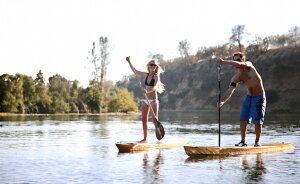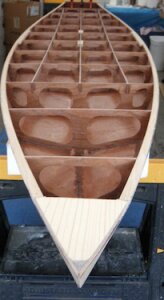A year or so ago, I made a big mistake. I picked up a copy of Wooden Boat magazine, which contained an article on how to build the Kaholo, a wooden stand up paddleboard (SUP). The Kaholo is a kit produced by Chesapeake Light Craft (CLC), a well-known manufacturer of small boat kits.
At the time, my schedule was pretty full both at work and at home. I can’t say I had much free time to do anything other than go skiing every weekend, so what possessed me to send off for the kit I cannot say. Pretty much everyone concluded I was nuts; an assessment no doubt facilitated by the knowledge that I had never been on a SUP before and I could hardly be described as a woodworker or handy in any way other than having the ability to call service people when needed. I couldn’t argue with my naysayers’ logic.
The kit duly arrived from back East and I got ready to work. First, I had to clean my garage and workbench so I could find the tools I needed. I discovered that I actually had plenty of duplicate tools bought from the local hardware store when I couldn’t find what I needed. All this took some time.
So did clearing out the basement to make space for the project. Man, who knew a basement was a black hole just sucking all kinds of objects into it. Getting this stuff out  was almost as impossible as pulling it out of a real black hole.
was almost as impossible as pulling it out of a real black hole.
Mission accomplished, I sat down to read the instruction manual and came up with a production schedule. CLC estimated the average builder would take 40 hours to build the SUP; this meant I could launch on the 4th of July. As Robbie Burns put it, “The best laid schemes o’ Mice an’ Men, gang aft agley.” For those of you who don’t know Gaelic, a rough translation means I was totally delusional.
The Kaholo comes in two lengths, 12 feet 6 inches and 14 feet; both cost $885 for the full kit. You can buy just the plans and the manual for $89; this will require you to source and cut the wood yourself. The full kit comes with precision cut Okoume marine plywood, fiberglass fabric and resin and a bunch of other things including a Japanese saw. Very cool. You’ll also want a random orbit sander, a jigsaw, plenty of clamps and other small tools. If you’ve already got these tools or can borrow them, you’re good to go with minimal additional outlay. I didn’t have them.
Around this point, you’re probably wondering, “Wouldn’t it be cheaper to just go out and buy a SUP?” Sure, you can head to REI or MEC and pick up a Bic SUP on sale for less than this kit cost. I doubt that you could find a SUP that had the handling and design characteristics of the Kaholo at the same price though. The Kaholo has a v-shaped bow that pierces through the waves and the buoyancy to rise up and over. Built correctly, the two versions weigh 29 and 32 pounds respectively, are fine racers that will allow you to surf long swells once your skills catch up to the board’s capabilities. Plus, they are beautiful.
CLC says there are no other kits out there that are easier for the first-time builder, and they may well be right. This article isn’t a “how to build a SUP” piece but rather a general overview of what you should be on the lookout for if you decide to build this or another kit. First, pretend the manual is the key to getting into heaven and read it front to back several times before you start the project. Make sure that you re-read each procedure a couple of times before you take the next step. Think it through. Do you understand what they wrote? When they identify a piece, have you identified the right piece or have you got it backwards because the damn thing is upside down?
You will get confused.
To keep the weight down, less is more. The manual contains grainy black and white photos and sometimes it’s hard to tell exactly what’s going on. This is especially important when you’re fiberglassing, filleting seams or sealing the interior. It’s easy to use too much of the resin and the next thing you’ll know, you have the Queen Mary to paddle. I’ve included some resources to help you along the way – take the time to read or view them, as you’ll find them invaluable.
The Kaholo is built using what’s called the “stitch and glue” method. This involves lining the pieces up and “stitching” them together using copper wire (supplied) through pre-drilled holes. The seams are then “glued” together using fiberglass resign with a thickening agent. Once cured, the wires are pulled out. The interior of the SUP has bulkheads and stringers to provide strength, and the entire inside is sealed with a thin coat of resin to waterproof it. The underside of the top deck is fiber-glassed for strength and the entire exterior is also fiber-glassed.
CLC reports it took five years to refine the design. They learned early on that the SUP needed a breather tube to equalize the inside and outside air pressure. If the sun heats up the SUP’s interior, the increased air pressure will blow the board apart; an eventuality that reportedly “might have happened during development.”
Fiberglassing isn’t difficult as long as you follow directions. The resin and the hardener have pumps that shoot out the correct proportions – you just have to count pumps. Less is more – it’s better to mix up another batch than waste or over-apply. The resin and hardener that CLC supplies is top-notch; if you run out, don’t go buy another brand. There’s something called amine blush, which is a wax-like layer that will rise to the surface when the epoxy hardens. You usually can’t see it, but if it isn’t removed, it will prevent any surface coating (paint, varnish, etc.) from curing properly. I ran out of the brand shipped with the kit and I ended up stripping and refinishing the SUP twice. Ouch.
There’s plenty of opportunity to customize your board. Paint it, varnish it, cover it with fabric, whatever; it’s up to you. With patience (especially in the sanding phase) and care, even a beginner will end up with a beautiful board they’ll be proud to ride.
(especially in the sanding phase) and care, even a beginner will end up with a beautiful board they’ll be proud to ride.
Addendum: My SUP was finally launched on September 30 and put away for the season the very same day. I’m looking forward to warm weather. X
Other Vendors/Kits
• Cedar Boat Works out of Portland, Oregon has a number of models.
• Surfboards.com in Burlington, Washington is another option.
• Wood Surfboard Supply has a number of nice looking models.
Resources:
First and foremost, CLC itself. You can phone or email them: they are really helpful and they get right back to you. Their website also has a builder’s forum and tips for boat builders where you can go find out how to deal with finishes, etc.
Wooden Boat Magazine: Issues 229 and 230 contain the two-part article on how to build the Kaholo that was my downfall. Digital copies can be purchased for $6.95 each and I highly recommend doing so. Wooden Boat also has forums where you can soak up others’ expertise before you screw up.
Videos: CLC has a sped-up video of the building process. It mostly makes you dizzy and isn’t of any practical use. There’s a professional builder by the name of Stephen Shrier who has 13 videos on YouTube demonstrating each step of the building process.